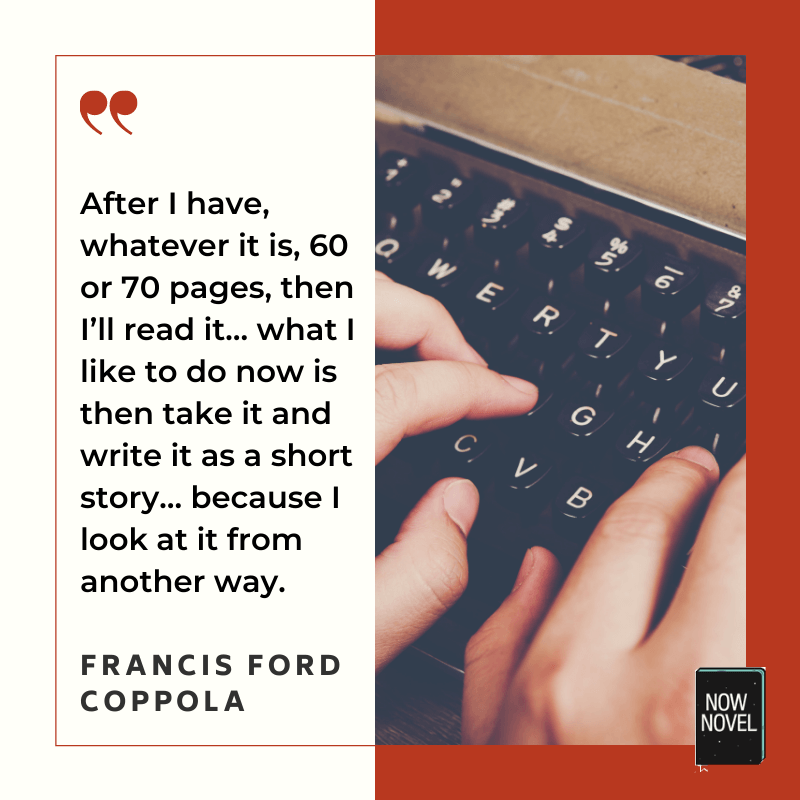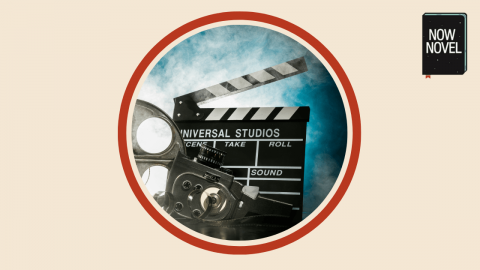How do you write a good screenplay? Or a novel worthy of film adaptation? Screenwriting tips by masters of visual storytelling help. Here are 8 great screenwriting ideas that apply to novels and other formats too:
Screenwriting tips that apply to novels too:
- Keep your eyes on the ground ahead
- Use platforms for your purpose
- Build characters via intentions and obstacles
- Find scenes that support your idea
- Solve problems using other mediums
- Avoid trying hard for style
- Trade in surprise for suspense
- Trust audiences’ intelligence
Keep your eyes on the ground ahead
The Japanese screenwriter, director and producer Akira Kurosawa is regarded as one of the most influential filmmakers of all time. His samurai epic Seven Samurai was voted the greatest foreign-language film in the BBC’s 2018 poll of international film critics.
In an interview sharing screenwriting tips on the writing process, Kurosawa compares writing to mountain-climbing. He advises patience and that we focus on the small progress we can make daily:
I think young people today don’t know the trick of it. They start and want to get to the end right away. When you go mountain climbing, the first thing you’re told is not to look at the peak but to keep your eyes on the ground as you climb […] If you keep looking at the top, you’ll get frustrated.
Akira Kurosawa, interview, translated.
Create a character outline now, or write your one-page idea summary. Take one more step towards the peak, then another.

Use platforms for your purpose
Artists face varied challenges due to complex intersections between elements of identity such as race, gender, age, class and sexual orientation, and how these relate to access, audience, money and power in creative industries.
Screenwriter, director and producer Ava DuVernay has spoken about how new platforms have enabled artists to claim more space and build their own audiences despite various forms of systemic exclusion:
As an artist, I’m grateful that I live at a time when access to cameras and distribution platforms and ways to reach audiences outside of the normal Hollywood infrastructure are more possible for me, a black person, a woman, than ever before. My voice as a storyteller and vision as a filmmaker can be amplified without the permission of the privileged few who have held marginalized creators at arm’s distance for decades.
Ava DuVernay in ‘AvaDuvernay on What Gives her Hope’ for Time, available here.
Think about promotional platforms such as social media, funding means such as Patreon or crowdfunding platforms, and how you can use these to build an audience invested in the stories you’re telling, on your own terms.
Build characters via intentions and obstacles
Aaron Sorkin, writer of the screenplays of A Few Good Men, The Social Network and other hit movies, echoes advice from celebrated authors such as Kurt Vonnegut and Ray Bradbury: Story is character.
Says Sorkin:
It all boils down to intention and obstacles. Somebody wants something; something’s standing in their way of getting it. They want the girl, they want the money, they want to get to Philadelphia—it doesn’t matter, but they have to want it bad. If they need it, that’s even better.
Aaron Sorkin, quoted by screencraft.org
It was Kurt Vonnegut who said ‘Every character should want something, even if it is only a glass of water.’ A detailed story is nothing without clear character motivations.
Whether you’re writing a film or a novel, knowing your characters inside out – their motivations, histories, desires, unique footprints – is vital.
Once you have a character in mind, ask what:
- they want at the start of the story
- they need at the start of the story (are these two things the same)?
- obstacles stand between them and their wants/needs
- ways their wants and needs, obstacles and solutions could change as your story proceeds
Find scenes that support your idea
Peter Morgan, CBE is the creator and showrunner of the successful historical series The Crown. He also wrote the screenplays for The Queen (2006) and Frost/Nixon (2008).
In an interview, Morgan shared helpful screenwriting tips on choosing what scenes to include when you have a wealth of material.
Although Morgan was speaking about writing historical screenplays, the same would apply if you can’t decide which scenes to put in a wholly fictitious story:
An idea comes first. And it’s a controlling idea that’s a theme. And then the scenes that I choose (often they span six months or a year and you could choose any number of them because these [historical figures] are busy people and they’ve done a lot). I will pick the ones that support my conjecture.
Peter Morgan, via Bafta Guru
Find an idea you are happy to commit to. This will make it easier to find scenes that develop your idea’s potential.
Solve problems using other mediums
Screenwriting tips from Francis Ford Coppola, the acclaimed director and co-writer of classic films and screen adaptations such as Apocalypse Now and The Godfather, include writing short story versions:
After I have, whatever it is, 60 or 70 pages, then I’ll read it… what I like to do now is then take it and write it as a short story… because I look at it from another way.
Francis Ford Coppola, quoted by screencraft.org here.
Working out the central characters and themes of a longer story in short isn’t a unique method to this screenwriting legend. Jhumpa Lahiri’s The Namesake and Virginia Woolf’s Mrs Dalloway both began as short stories.

Trade in surprise for suspense
From process to craft, the icon of suspense in film, Sir Alfred Hitchcock, offers great advice.
In describing the difference between mystery and suspense, for example, Hitchcock stresses that suspense differs from mystery because it involves emotion:
Hitchcock elsewhere compared the fifteen seconds of viewer (or reader) surprise we might get out of the unexplained mystery of a sudden explosion to the fifteen minutes of a suspenseful situation with sufficient exposition:
We are now having a very innocent little chat. Let us suppose that there is a bomb underneath this table between us. Nothing happens, and then all of a sudden, “Boom!” There is an explosion. The public is surprised, but prior to this surprise, it has seen an absolutely ordinary scene, of no special consequence.
Now, let us take a suspense situation. The bomb is underneath the table and the public knows it, probably because they have seen the anarchist place it there. The public is aware that the bomb is going to explode at one o’clock, and there is a clock in the decor. The public can see that it is a quarter to one.
In these conditions this innocuous conversation becomes fascinating because the public is participating in the scene. The audience is longing to warn the characters on the screen: “You shouldn’t be talking about such trivial matters. There’s a bomb beneath you and it’s about to explode!”
Hitchcock, quote on Goodreads here.
In the first case we have given the public fifteen seconds of surprise at the moment of the explosion. In the second we have provided them with fifteen minutes of suspense.
Avoid trying hard for style
Often, beginning screenwriters’ and authors’ work is self-indulgent in style. The author’s hand is constantly visible in the work, practically shouting ‘Here I am! This is my beautiful/funny/clever persona!’
Stronger style emerges when the author’s hand is less visible. Style in the work builds through choices to do with language, imagery, tone and idea, rather than a conscious pose or mimicry. It comes from movement and tableau. Theme, repetition and variation.
When The Guardian asked authors and screenwriters for their 10 writing tips, the playwright, screenwriter and director Sir David Hare said this among his other screenwriting tips:
Style is the art of getting yourself out of the way, not putting yourself in it.
Sir David Hare, quoted by The Guardian.
In other words, let your storytelling style emerge naturally from creative choices you make. Let style speak through imagery, language, rhythm; through what feels authentic to your idea, genre, message and/or medium.
As with most ‘rules’, there are exceptions. Some genres, for example parody, rely on exaggerated, put-on style (such as how Tarantino pays homage to exploitation flicks, pushing their tropes ever more over-the-top). However, this approach to style is a conscious, informed and creative choice, rather than a rookie style error.
Trust audiences’ intelligence
Actor, comedian, writer, producer and director Jordan Peele had a critical and box office success with his 2017 horror movie Get Out, which he directed, wrote, and co-produced.
Peele’s sketch-comedy background meant he was no stranger to bringing audiences along for wild, unpredictable rides.
One of Peele’s screenwriting tips applies to screenplays and novels equally:
Give the audience the benefit of doubt. They will go there. They’re going everywhere. How do I take them back from that point and convince them [otherwise]?
Jordan Peele, quoted by The Script Lab here.
Trust your reader can infer certain details from context, be it in dialogue or a scenic tableau you’ve set up.
Avoid needless repetition. Alert readers (and viewers) catch signs, suggestions and inferences more often than we think.
Start writing now and outline your novel or screenplay in easy character profiles and scene summaries.


2 replies on “Screenwriting tips: 8 big ideas (that apply to novels too)”
Thank you, it’s just what I needed to hear.
Hi Aria, it’s a pleasure. Thank you for reading our blog and for the feedback! Happy writing.